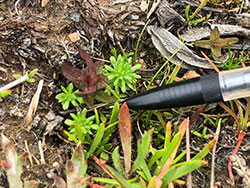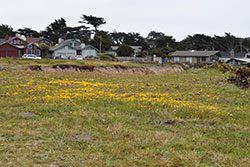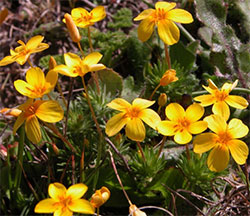
A coast yellow leptosiphon seedling.

Residential development on the San Mateo coast threatens coast yellow leptosiphon’s habitat.

Coast yellow leptosiphon is a low growing annual from the Phlox family which typically blooms in April and May.
The world is closing in on coast yellow leptosiphon.
The endangered plant exists in only one known location on earth — an 1,800 square foot plot on Vallemar Bluff in Moss Beach, about 20 miles south of San Francisco. The low-growing annual from the Phlox family features bright yellow flowers with fused petals and typically blooms in April and May.
Erosion caused by rain, waves and other factors is making the bluff that the plant perches on less stable. One study showed that the bluff receded 48 feet between 1908 and 2014. Scientists believe it will continue to recede almost six inches per year moving forward. Climate change could accelerate the erosion process.
“The plant could be almost completely gone in the next 50 years due to bluff-top erosion alone,” said Cherilyn Burton, a senior environmental scientist in CDFW’s Native Plant Program.
Slightly inland from where coast yellow leptosiphon grows is a planned four-unit housing development. The project was approved in March 2019. Although the development project mitigates for direct impacts to the plant, it also eliminates an area that could have been used to help restore the species.
Then there are the indirect impacts caused by urban development. Some aspects of urban design, like installation of storm drainage and landscape irrigation systems, could alter water runoff patterns around the plant’s habitat. The new housing development could also mean increased use of fertilizers, pesticides and other chemicals which through runoff could flow into the plant’s habitat and harm the soil.
“An increase in human activity can cause soil and habitat disturbances, which creates conditions that can be favorable to the spread of non-native plants,” said Burton.
Growing among the coast yellow leptosiphon is freeway iceplant—a fast-growing, invasive species that dominates the landscape and outcompetes other plants for light, nutrients, water, space and other resources. Coast yellow leptosiphon is also threatened by non-native plant species like rough cat’s ear, hare barley and cut leaf plantain. It may also face negative impacts from non-native slugs which can be detrimental to the plant’s seedlings.
“There’s so much going up against this plant. We may have to get creative to save it,” said Burton.
If there’s a bright spot in coast yellow leptosiphon’s story, it may be the lack of opposition in getting it listed as a protected species. In 2016, the California Fish and Game Commission designated coast yellow leptosiphon as a candidate species under the California Endangered Species Act. The plant was officially listed as an endangered species in 2018.
Burton recalls the heavy workload that came with preparing her recommendation to the Commission, and her relief upon hearing the Commission’s vote.
“They voted on it right then – right after I gave my presentation. Sometimes the commissioners have questions. But this time there was silence, and then one of the commissioners said, ‘Well, I think we can all agree that this plant meets the criteria.’”
Options to save coast yellow leptosiphon are limited, but there are a few. Scientists are on the lookout for additional suitable habitat. However, most suitable areas already contain rare and sensitive plants to which scientists must consider potential impacts. If additional suitable habitat is found, there will likely be land use and management issues to be worked out.
“The biggest problem is there’s just not a lot of habitat left in the area, and it’s not clear how far away we could go before the microclimate or other conditions would be too different to be suitable,” said Burton.
Another conservation strategy could include long-term seed storage at a botanical garden or other suitable facility to preserve seeds for the future.
Meanwhile, one landslide at the bluff’s edge could have serious consequences.
“Because of its vulnerability and rarity, losing any portion of the plant’s population could result in extinction,” said Burton.
CDFW Photo. Top Photo:
CDFW scientists Jeb Bjerke, Cherilyn Burton and Bill Condon (retired) at Moss Beach in San Mateo County doing fieldwork to support coast yellow leptosiphon.
###
Media Contact:
Ken Paglia, CDFW Communications, (916) 825-7120